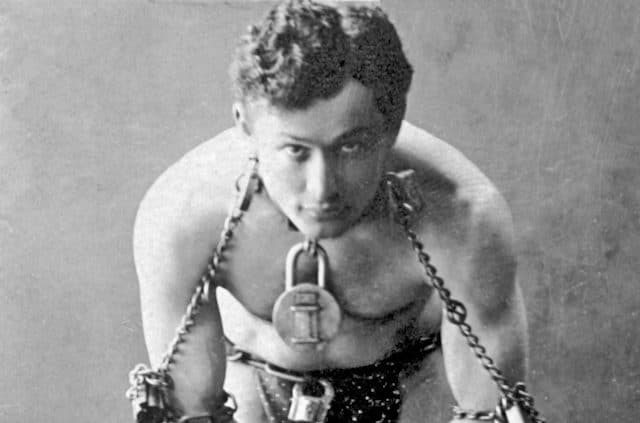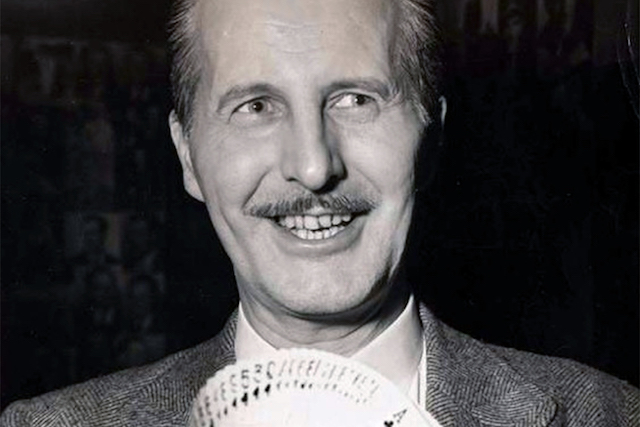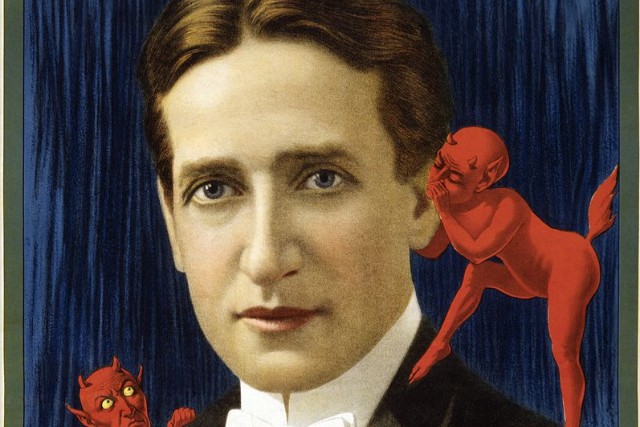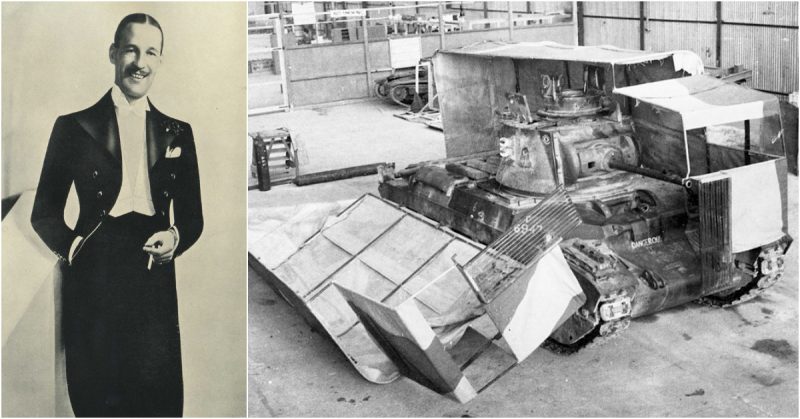Magic is a performance art that goes back thousands of years. The cups and balls, one of the fundamental tricks of magic that is still being performed today, was also done back in Roman times. The earliest named magician is even older than that, going all the way back to the first dynasties of Egypt. He was a legendary figure named Dedi, or Djedi, who was mentioned in the mythical Westcar Papyrus and performed conjuring effects for Pharaoh Khufu of the 4th Dynasty.
With that in mind, today we are going to be taking a trip through the history of magic, looking at some of the greatest illusionists, mentalists, escapologists, and sleight of hand experts from the past who paved the way for the likes of David Blaine, Penn & Teller, Lance Burton, and many other contemporary magicians.
8. Houdini and Hardeen

Since this list is in no particular order, we might as well start off with the one famous historical magician that everyone has heard of – Harry Houdini.
Born Erik Weisz in 1874 in Austria-Hungary, he immigrated to America at an early age. He turned to magic and adopted the stage name “Harry Houdini,” in honor of another great magician we might learn about later. He became popular for his feats of escapology, particularly the ease with which he escaped out of handcuffs.
As Houdini’s fame grew, so did the grandness of his tricks. The milkcan escape was a popular one, but Houdini’s showstopper was the Chinese Water Torture Cell, where he was lowered upside-down, chained and handcuffed, into a water-filled tank.
Outside of his stage career, Houdini took an immense dislike to psychics, mediums, and anybody else who pretended to have genuine supernatural powers. He used his knowledge to debunk many spiritualists, showing how they pulled off their cons using basic magic tricks that involved no supernatural elements.
Houdini might be well-remembered even now, a hundred years after his death, but the same cannot be said for his brother, even though he was a successful magician, as well. He was billed as Hardeen, and continued performing for almost 20 years after his brother’s death, using many of the tricks that Houdini bequeathed to him.
7. The Great Lafayette

A contemporary of Houdini, the Great Lafayette is barely remembered today, although at his peak, he was not only more successful than Houdini, but he was the highest-paid entertainer in all of theater. But today, those who do mention him usually bring up his bizarre death, which was incredibly fitting for a magician performing one last trick.
Lafayette was born Sigmund Neuberger in Munich, Germany, in 1871, and immigrated to America with his family when he was a teenager. He started in vaudeville, and became inspired to turn to magic by a popular Chinese illusionist named Ching Ling Foo, but more on that later. Lafayette discovered that he was quite adept at quick changes, but it was his flair and ambition to stage large-scale performances with beautiful set-pieces and dozens of extras that brought him fame and fortune. He developed a reputation as an unpleasant and solitary bachelor, and his greatest friend was his dog Beauty, a cross-breed terrier he received as a gift from Houdini and whom he spoiled rotten with private suites, jewel-encrusted collars, and five-course meals.
His showstopper was an illusion called “The Lion’s Bride” which ended with Lafayette switching places with an actual lion, but it also involved dozens of dancers, jugglers, contortionists, and fire-eaters, all in costume and on a stage made to resemble a Persian harem. It was quite a sight to see, but it also led to his strange demise on May 9, 1911, when The Great Lafayette performed his illusion at the Empire Palace Theater in Edinburgh. A lamp broke and caused a fire, and the elaborate, heavily-carpeted set immediately went up in flames.
Eleven people died in the fire, among them Lafayette, whose charred body was only identified by his ornate costume. However, after he was buried, another body was found in the wreckage and this one turned out to be the real Lafayette. The first one had been his body double.
6. Dai Vernon

His name might not ring any bells with the general public. There were never any stadium shows or flashy stages in Las Vegas, but go ask the professionals who the most influential people in magic were and the name “Dai Vernon” will always be near the top of the list. A real magician’s magician, Vernon performed magic for over 90 years, specializing in sleight of hand. He developed hundreds of tricks and techniques, many which are still used today. He acted as mentor and teacher to countless magicians who followed him and was always praised for the generous way with which he dispensed knowledge and advice. For this, he became known in magic circles simply as “The Professor.”
Born David Frederick Wingfield Verner in Ottawa, Ontario, Canada, in 1894, Vernon learned his first trick from his father when he was seven years old. He later jokingly complained that it took him so long, lamenting that he wasted the first six years of his life. By the time he was a teenager, he was already adept at sleight-of-hand and, by his early 20s, Vernon had moved to New York City to become a professional magician.
His career took a giant leap forward in 1919, when he performed a card trick for Harry Houdini who, by that time, was already a huge name in magic. Houdini might have been known for his escapology, but he was well-versed in all kinds of magic and boasted that he could figure out any card trick if he saw it performed three times. Vernon did his card trick for Houdini seven times and the magician could still not work out how it was done. From that point on, Dai Vernon billed himself as “The Man who Fooled Houdini.”
In the 1960s, Vernon moved to Los Angeles where he helped found the famed Magic Castle, where he became their magician-in-residence for the last three decades of his life, always ready to help out the up-and-comers who walked through its doors.
5. Ching Ling Foo and Chung Ling Soo

Rivalries are pretty common in magic, but one that went to a whole other level occurred a hundred years ago between Ching Ling Foo and Chung Ling Soo over who was the “the Original Chinese Conjurer.”
The answer, by the way, is Ching Ling Foo. He was actually Chinese, seemingly born under the name Chee Ling Qua in mid 19th century Beijing. He came to America, where he wowed western audiences using traditional Chinese magic that had been popular in his homeland for hundreds of years.
Chung Ling Soo, on the other hand, was a guy named William Robinson born in Westchester County, New York. We are unsure if he harbored any kind of animosity towards Ching and actively wanted to hurt his career or if he simply saw a popular act and decided to imitate it. Either way, Robinson took on the appearance of a Chinese man and started promoting himself as Chung Ling Soo, making sure to maintain his role whenever he was on stage or in public.
Ching, of course, heard of the man who was ripping off his act and publicly called out Chung Ling Soo for being an imposter. In 1905, Ching even threw down a challenge, offering a prize of £1,000 if Chung could recreate ten of his tricks. The latter agreed, but Ching backed out at the last moment. This was probably because he realized he was going to lose the money, but publicly he blamed the newspapers for being more interested in covering the scandal than exposing the fraud.
The rivalry came to an abrupt and violent end on March 23, 1918, when Chung Ling Soo (that’s the fake one, by the way) performed in London. His biggest trick was called “Condemned to Death by the Boxers” and it was a bullet catch trick where his assistants dressed up as Boxer rebels, walked up on stage and shot him with rifles.
The weapons were gimmicked, of course, and no actual bullets were supposed to be fired, but one of the guns had been poorly maintained and shot a real bullet straight into the magician’s chest. For the first time since adopting the character of Chung Ling Soo, Robinson broke character and witheringly asked his assistants to lower the curtain. He died the following day, although ultimately his shocking demise ensured that he became the more famous of the two “Original Chinese Conjurers.”
4. The Herrmann Family

The Herrmanns have been called the “first family of magic,” as it was full of people who kept outdoing their predecessors. It all started with Samuel Herrmann, an 18th century German physician who practiced magic as a hobby. He may have performed professionally, we’re not really sure about that, but he definitely did lots of tricks for his children who developed a love for magic early on in life. Unsurprisingly, his eldest son, Compars Herrmann, became a magician, and was successful enough that he toured throughout Europe.
At the same time, Compars mentored his brother Alexander, who was 27 years younger than him, born in 1844 in Paris. They both performed under the name “Herrmann the Great,” but, to avoid confusion, one usually toured in Europe while the other toured in the United States. The older Herrmann eventually retired while his younger sibling became far more popular thanks to his shows which were significantly more elaborate and glamorous.
At one point, Alexander Herrmann was booked for a three-year run at London’s Egyptian Hall, a venue which had developed a reputation as being the place where the world’s best magicians performed. There, he met a 22-year-old dancer who was the daughter of one of the founders of the exhibition hall. Her name was Adelaide Scarcez and the two quickly fell in love. She became his assistant and, in 1875, they married.
Soon enough, Adelaide’s own talent for magic started showing, as she not only learned all her husband’s tricks, but also began developing new ones. In 1896, Alexander Herrmann died of a sudden heart attack and Adelaide decided to carry on his legacy by performing on her own. She kept performing for 35 more years, being remembered as the “Queen of Magic.”
3. Howard Thurston

In his time, Howard Thurston put on performances on a grand scale unlike any that had been seen before. The advent of railroads allowed him to easily travel from one city to the next with 40 tons of equipment packed into eight different railcars. It was the largest magic show in the world, but he was eventually eclipsed by younger magicians like Harry Houdini and today, Howard Thurston is all but forgotten.
He was born in 1869 in Columbus, Ohio, but his early years are somewhat clouded in mystery. Contemporary reports claimed that Thurston was studying to become a minister before turning to magic, but modern historians discovered that the teenager Thurston was, in fact, a criminal delinquent who only turned to religion to avoid a harsher sentence. Even so, it seems Thurston was successful not only in overcoming his rebellious ways, but also in hiding his past so that he could cultivate the image of a consummate gentleman, well-dressed and soft-spoken.
In terms of magic, Thurston’s bread and butter were card tricks. He promoted himself as the “King of Cards,” and his specialty involved summoning cards selected by audience members from outlandish and seemingly impossible places. He also performed a popular floating woman illusion called the “Levitation of Princess Karnac.” This was one trick that he picked up from his mentor and one-time partner, Harry Kellar, a man who could also be included on a list like this. However, Thurston made every trick he performed his own by adding a lot of showmanship, with circus elements, dancing girls, and even a full orchestra. That way, he turned even a standard card trick into a unique experience, part of what he dubbed to be the “Wonder Show of the Universe.”
2. The Maskelynes

Magic sometimes runs in the family and nowhere is that more evident than the Maskelyne family which produced three generations of influential performers.
It all started with John Nevil Maskelyne, born in Cheltenham, England, in 1839. He became involved with magic when he saw a show of the Davenport brothers, two American spiritualists who claimed to possess genuine supernatural powers. Upon seeing their spirit cabinet illusion, Maskelyne figured out how the trick was done. He not only called out the Davenport brothers for being frauds, but also promised he could recreate their performance using only magical trickery and no supernatural abilities. Which he did, with the help of a friend named George Alfred Cooke, and from that point on, he became a professional magician.
Maskelyne developed many groundbreaking illusions, which still serve as inspiration for tricks performed today. He is usually credited with the invention of the original levitation routine, although a few other magicians also make that claim. He had a talent for engineering and built an automaton named Psycho which could seemingly play cards with real people, perform conjuring tricks and smoke cigarettes. Like Houdini, Maskelyne strongly disliked mediums and psychics and spent his career debunking frauds.
His son was Nevil Maskelyne, born in 1863. He also became a successful magician but, just like his father, also showed a strong interest in engineering. He was more active as an inventor and held multiple patents in wireless telegraphy.
His own son was Jasper Maskelyne, born in 1902. He is best remembered today for his claims of using his magic skills during World War II to orchestrate large-scale ruses and deceptions to fool the Nazis. He boasted in his autobiography of using special mirrors to make the Suez Canal disappear and creating a second, fake port of Alexandria as a target for enemy bombers. There is no evidence that anything like this ever happened. While Maskelyne was a part of MI9 during the war, his involvement was probably minimal, and everything else was just smoke and mirrors.
1. Jean-Eugène Robert-Houdin

Today, magic shows are played in grand theaters or arenas, but there was a time when they were mostly confined to local fairs, regarded as only a distraction for the lower classes. However, French magician Jean-Eugène Robert-Houdin made magic popular with the royals and the aristocracy, performing for King Louis Philippe and Emperor Napoleon III. He had his own theater in Paris where he entertained the upper classes with some of his most famous illusions which included a levitation act, a mind-reading trick he called “Second Sight,” and the “Light and Heavy Chest.” Instead of the traditional wizard’s robes, Robert-Houdin preferred evening dress, wearing a black tailcoat, with gloves and a walking cane, which has since become the stereotypical outfit of the magician. It’s not hard to see why he is now considered the father of modern magic.
Robert-Houdin was born in 1805 in Blois. Initially, he apprenticed to become a watchmaker and later used his engineering skills in magic, by constructing automatons and other mechanical devices. One of these was the aforementioned “Light and Heavy Chest,” which might have been Robert-Houdin’s greatest trick, making use of the newly-discovered electromagnetism. The magician first asked a member of the audience, usually a child, to come and pick up a small chest on stage. They did it with ease, but then Robert-Houdin also asked a man to do the same thing, and they were unable to do it because the chest suddenly became incredibly heavy. Unbeknownst to the audience, the magician had turned on a powerful electromagnet inside the chest, which was attracted to something placed under the stage.
In 1856, Robert-Houdin actually put his skills to use to prevent a rebellion. Louis-Napoleon sent him to French Algeria to combat the influence of certain Muslim religious leaders who were using alleged magical powers to sway their people against the French government. Robert-Houdin not only wowed the local officials with his performance, but also made it clear that everything he did was the result of skill and not sorcery.